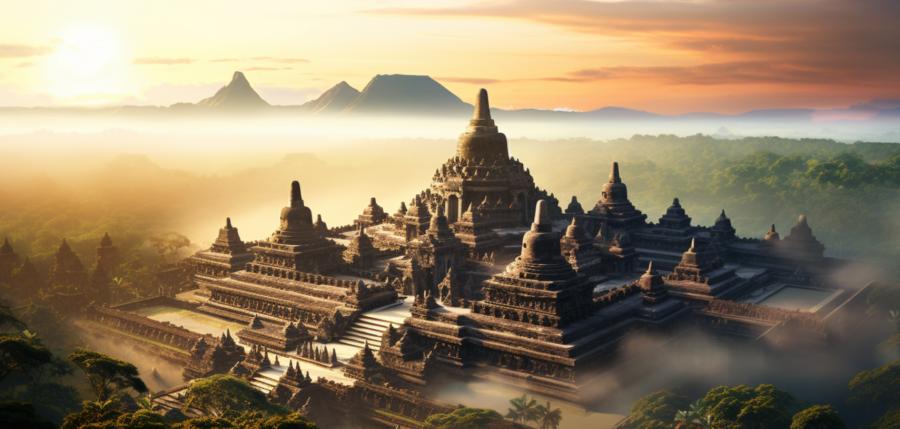The Mystical Charm of Indonesia's Borobudur Temple

Introduction
Oh, the grandiosity of man's attempts to scratch out his tiny existence on the face of eternity! As I pondered the impermanence of life, I found myself at the foot of Borobudur Temple in Indonesia, a magnificent 9th-century Mahayana Buddhist monument. As I gazed upon its tiered platforms, ornate reliefs, and conical stupas, I was struck by the sheer audacity of the human spirit in its quest for spiritual transcendence and the mysteries of existence.A Brief History
Borobudur, a UNESCO World Heritage Site, is the largest Buddhist temple in the world, covering an area of over 2,500 square meters and comprising more than 2 million stone blocks. It is believed to have been built between AD 750 and 842, during the reign of the great Sailendra Dynasty. The temple fell into disuse around the 14th century, when the Javanese people converted to Islam, and was subsequently swallowed by the jungle, finally being rediscovered in 1814 by Sir Thomas Stamford Raffles.The Stairway to Enlightenment
As I climbed the stairway to enlightenment, I was struck by the grandiosity of Borobudur. It is constructed as a series of six terraces, each representing a different stage in the journey to enlightenment, culminating in the massive central stupa at the top. This stupa is intended to represent the ultimate goal of Nirvana and is a sight to behold, especially when the rising sun casts its warm glow upon the stone, bathing it in a celestial light.- The first terrace represents the world of desire, filled with cravings, lust, and greed.
- The second terrace is the world of forms, where the senses and worldly attachments reign supreme.
- The third terrace symbolizes the world of formlessness, where the senses and worldly attachments begin to fade away.
- The fourth terrace is the realm of nothingness, where the self and reality begin to dissolve.
- The fifth terrace represents the realm of consciousness, where the mind is free from the constraints of earthly desires.
- The sixth terrace is the realm of neither perception nor non-perception, where the mind transcends the limits of consciousness.
A Walk Among the Stupas
Upon reaching the top of Borobudur, I found myself surrounded by a veritable forest of stupas, each housing a unique Buddha statue. These 72 perforated stupas, arranged in concentric circles, seemed to float ethereally above the landscape, suspended in a state of serene transcendence. As the wind whispered through the perforations, I couldn't help but imagine the cosmic vibrations of the universe reverberating through the temple, imbuing it with an otherworldly power.Embracing the Mystical Charm
As I walked amongst the stupas, the mystical charm of Borobudur worked its magic on me. The temple seemed to exist in a realm beyond time and space, suspended between the earth and the heavens. The very air around the temple seemed to vibrate with a palpable energy, as if the spirit of the Buddha himself still lingered within the hallowed grounds, guiding pilgrims on their quest for enlightenment.The intricate carvings that adorned the walls of the temple seemed to come alive as the sun cast its shadows upon them, revealing the profound wisdom and deep spiritual insight of the ancient Javanese people. As I gazed upon these ancient reliefs, I couldn't help but marvel at the countless generations of artisans who had dedicated their lives to the creation of this magnificent monument, a testament to the enduring power of faith and the boundless creativity of the human spirit.
Practical Advice
For those intrepid travelers seeking to experience the mystical charm of Borobudur for themselves, I offer the following practical advice:- Arrive early in the morning to witness the breathtaking sight of the sun rising over the temple.
- Ensure you wear comfortable clothing and shoes, as the ascent to the top can be quite steep and challenging.
- Bring a hat and sunscreen, as the sun can be quite intense during the day.
- Take your time to fully explore the temple and its many reliefs, as there is much to see and experience.
- Remember to treat the temple with the respect and reverence it deserves, as it is not only a cultural and historical treasure but also a sacred place of worship for many people.
Article kindly provided by myfavouritehols.com
Latest Articles
- How to Plan Around Peak Congestion Days for Mountain Trips
- Mapping Your First Mountain Resort Loop Without Losing Your Sanity
- How Pro Kitchen Renovations Quietly Increase Booking Confidence in Self-Catering Stays
- Discover a City's Real Character From the Backseat
- How to Make Airport Layovers Surprisingly Productive
- From HVAC to ROI: the Hidden Economics of Sustainable Hotel Design
- How to Plan Your Day Tours to Minimize Crowds and Maximize Serendipity
- From Tourist to Observer: How to Photograph a City Like a Local
- Seasonal Shifts in Abandoned Turkish Valleys Reveal Clues About Heritage Site Decay
- Mastering Group Travel Planning for Events in Fort Lauderdale
- Beyond the Beach Bus: Hidden Palm Beach Spots Worth the Group Ride
- Chrono-Travel and Time Zone Acrobatics on a Coach
- Hidden Miami Charter Bus Routes to Secret Beaches, Local Food Gems, and Underrated Attractions
- More Than Just Ice - Unexpected Events at Amerant Bank Arena
- Madrid's Strangest Museums and Attractions You Never Knew Existed
- Disaster-Proof Rentals: A Flood-Resilient Guide for Holiday Homeowners
- Following the Footsteps of Filmmakers: Morocco's Iconic Movie Locations You Can Visit
- Hidden Gems Along Morocco's Coastline
- Tastes of Miami: Culinary Tours for the Global Foodie
- Milwaukee's Hidden Green Gems: Nature's Best Kept Secrets

